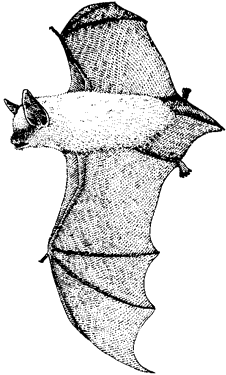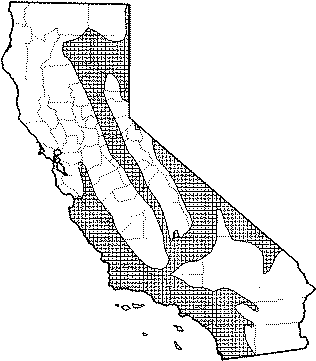
Western Small-footed Myotis
Distribution, Abundance, and Seasonality
The small-footed myotis is a common bat of arid uplands in California. In coastal California it occurs from Contra Costa Co. south to the Mexican border. It also occurs on the west and east sides of the Sierra Nevada, and in Great Basin and desert habitats from Modoc to Kern and San Bernardino cos. It occurs in a wide variety of habitats, primarily in relatively arid wooded and brushy uplands near water. The summer and winter ranges appear to coincide, but there are few records from winter. This species is found from sea level to at least 2700 m (8900 ft).

Range Map
Specific Habitat Requirements
Feeding: This species feeds on a variety of small flying insects. Prey includes moths, flies, beetles, and bugs. Foraging flight is slow and maneuverable. The small-footed myotis often is seen foraging among trees and over water.
Cover: This bat seeks cover in caves, buildings, mines, crevices, and occasionally under bridges and under bark. Separate night roosts may be used, and have been found in buildings and caves. Groups of 50, or more, may inhabit a hibernation site.
Reproduction: Maternity colonies of females and young are found in buildings, caves, and mines. Such colonies usually contain 12-20 individuals.
Water: This species requires water, and often is seen to drink soon after emergence. Humid roost sites are preferred.
Pattern: The small-footed myotis is a bat of arid, upland habitats. It prefers open stands in forests and woodlands as well as brushy habitats. Streams, ponds, springs, and stock tanks are used for drinking and feeding.
Species Life History
Activity Patterns: Nocturnal. Hibernates. Emerges at sunset. Reported activity peaks include 30 min after sunset and 2-3 hr after sunset (Cockrum and Cross 1964, Jones 1965). This species hibernates from November-March. It has a remarkable tolerance for cold, often hibernating in cold, drafty sites.
Seasonal Movements / Migration: Probably makes local movements to suitable hibernacula.
Home Range: No data found.
Territory: No data found.
Reproduction: Mates in the fall. The young are born from May through June, with a peak in late May. Usually there is a single young, but twins are common (Tuttle and Heaney 1974). Lactating females were found in June and July in New Mexico (Findley et al. 1975). Most young are flying by mid-August. Maximum recorded longevity is 12 yr (Paradiso and Greenhall 1967).
Niche: This species may be found feeding or roosting with other bat species.
Sources & References
California Department of Fish and Game, 1999.
California's Wildlife, Sacramento, CA.
Written by: J. Harris, reviewed by: P. Brown, edited by: S. Granholm, R. Duke
Barbour, R. W., and W. H. Davis. 1969. Bats of America. Univ. of Kentucky Press, Lexington. 286pp. Black, H. L. 1974. A north temperate bat community: structure and prey populations. J. Mammal. 55:138-157. Cockrum, E. L. 1952. Mammals of Kansas. Univ. Kansas Publ. Mus. Nat. Hist. No. 7. 303pp. Cockrum. E. L., and S. P. Cross. 1964. Time of bat activity over waterholes. J. Mammal. 45:635-636. Davis, R., and E. L. Cockrum. 1963. Bridges utilized as day roosts by bats. J. Mammal. 44:428-430. Davis, W. H. 1955. Myotis subulatus leibii in unusual situations. J. Mammal. 36:130. Fenton, M. B. 1972. Distribution and overwintering of Myotis leibii and Eptesicus fuscus (Chiroptera:Vespertilionidae) in Ontario. Life Sci. Occas. Pap. R. Ont. Mus. 21:1-8. Findley, J. S., A. H. Harris, D. E. Wilson, and C. Jones. 1975. Mammals of New Mexico. Univ. New Mexico Press. Albuquerque. 360pp. Jones, C. 1965. Ecological distribution and activity records of bats of the Mogollon Mountains area of New Mexico and adjacent Arizona. Tulane Studies Zool. 12:93-100. Koford, C. B., and M. R. Koford. 1948. Breeding colonies of bats, Pipistrellus hesperus and Myotis subulatus melanorhinus. J. Mammal. 29:417-418. Martin, R. L., J. T. Pawluk, and T. B. Clancy. 1966. Observations on hibernation of Myotis subulatus. J. Mammal. 47:348-349. Paradiso, J. L., and A. M. Greenhall. 1967. Longevity records for American bats. Am. Midl. Nat. 78:251-252. Studier, E. H., J. W. Proctor, and D. J. Howell. 1970. Diurnal body weight loss and tolerance of weight loss in five species of Myotis. J. Mammal. 51:302-309. Tuttle, M. D., and L. R. Heaney. 1974. Maternity habits of Myotis leibii in South Dakota. South. Calif. Acad. Sci. Bull. 73:80-83. Whitaker, J. O., Jr., C. Maser, and S. P. Cross. 1981. Food habits of eastern Oregon bats, based on stomach and scat analyses. Northwest Sci. 55:281-292.
California Animal Facts | California's Wildlife